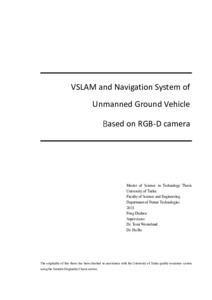VSLAM and Navigation System of Unmanned Ground Vehicle Based on RGB-D Camera
Feng, Duzhen (2019-04-09)
VSLAM and Navigation System of Unmanned Ground Vehicle Based on RGB-D Camera
Feng, Duzhen
(09.04.2019)
Julkaisu on tekijänoikeussäännösten alainen. Teosta voi lukea ja tulostaa henkilökohtaista käyttöä varten. Käyttö kaupallisiin tarkoituksiin on kielletty.
avoin
Julkaisun pysyvä osoite on:
https://urn.fi/URN:NBN:fi-fe2019052717334
https://urn.fi/URN:NBN:fi-fe2019052717334
Tiivistelmä
In this thesis, ROS (Robot Operating System) is used as the software platform and a simple unmanned ground vehicle that is designed and constructed by myself is used as the hardware platform. The most critical issues in the navigation technology of unmanned ground vehicles in unknown environments -SLAM (Simultaneous Localization and Mapping) and autonomous navigation technology are studied. Through the analysis of the principle and structure of visual SLAM, a visual simultaneous localization and mapping algorithm is build. Moreover, accelerate the visual SLAM algorithm through hardware replacement and software algorithm optimization. RealSense D435 is used as the camera of the VSLAM sensor. The algorithm extracts the features from the data of depth camera and calculates the odometry information of the unmanned vehicle through the features matching of the adjacent image. Then update the vehicle’s location and map data using the odometry information.
Under the condition that the visual SLAM algorithm works normally, this thesis also uses the 3D map generated to derive the real-time 2D projection map. So as to apply it to the navigation algorithm. Then this thesis realize autonomous navigation and avoids the obstacle function of unmanned vehicle by controlling the driving speed and direction of the vehicle through the navigation algorithm using the 2D projection map. Unmanned ground vehicle path planning is mainly two parts: local path planning and global path planning. Global path planning is mainly used to plan the optimal path to the destination. Local path planning is mainly used to control the speed and direction of the UGV. This thesis analyzes and compares Dijkstra’s algorithm and A* algorithm. Considering the compatible to ROS, Dijkstra’s algorithm is finally used as the global path-planning algorithm. DWA (Dynamic Window Approach) algorithm is used as Local path planning. Under the control of the Dijkstra’s algorithm and the DWA algorithm, unmanned ground vehicles can automatically plan the optimal path to the target point and avoid obstacles. This thesis also designed and constructed a simple unmanned ground vehicle as an experimental platform and design a simple control method basing on differential wheeled unmanned ground vehicle and finally realized the autonomous navigation of unmanned ground vehicles and the function of avoiding obstacles through visual SLAM algorithm and autonomous navigation algorithm.
Finally, the main work and deficiencies of this thesis are summarized. And the prospects and difficulties of the research field of unmanned ground vehicles are presented.
Under the condition that the visual SLAM algorithm works normally, this thesis also uses the 3D map generated to derive the real-time 2D projection map. So as to apply it to the navigation algorithm. Then this thesis realize autonomous navigation and avoids the obstacle function of unmanned vehicle by controlling the driving speed and direction of the vehicle through the navigation algorithm using the 2D projection map. Unmanned ground vehicle path planning is mainly two parts: local path planning and global path planning. Global path planning is mainly used to plan the optimal path to the destination. Local path planning is mainly used to control the speed and direction of the UGV. This thesis analyzes and compares Dijkstra’s algorithm and A* algorithm. Considering the compatible to ROS, Dijkstra’s algorithm is finally used as the global path-planning algorithm. DWA (Dynamic Window Approach) algorithm is used as Local path planning. Under the control of the Dijkstra’s algorithm and the DWA algorithm, unmanned ground vehicles can automatically plan the optimal path to the target point and avoid obstacles. This thesis also designed and constructed a simple unmanned ground vehicle as an experimental platform and design a simple control method basing on differential wheeled unmanned ground vehicle and finally realized the autonomous navigation of unmanned ground vehicles and the function of avoiding obstacles through visual SLAM algorithm and autonomous navigation algorithm.
Finally, the main work and deficiencies of this thesis are summarized. And the prospects and difficulties of the research field of unmanned ground vehicles are presented.
